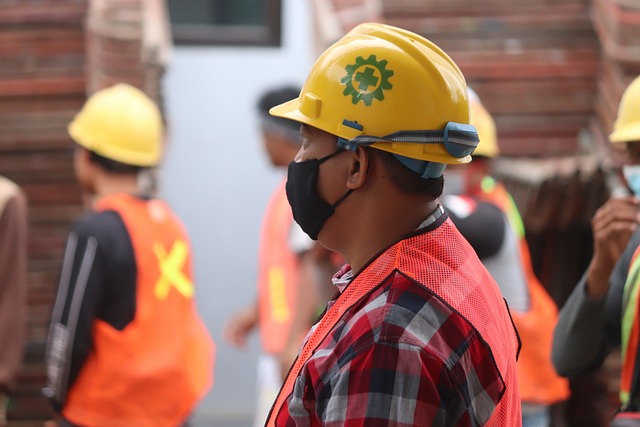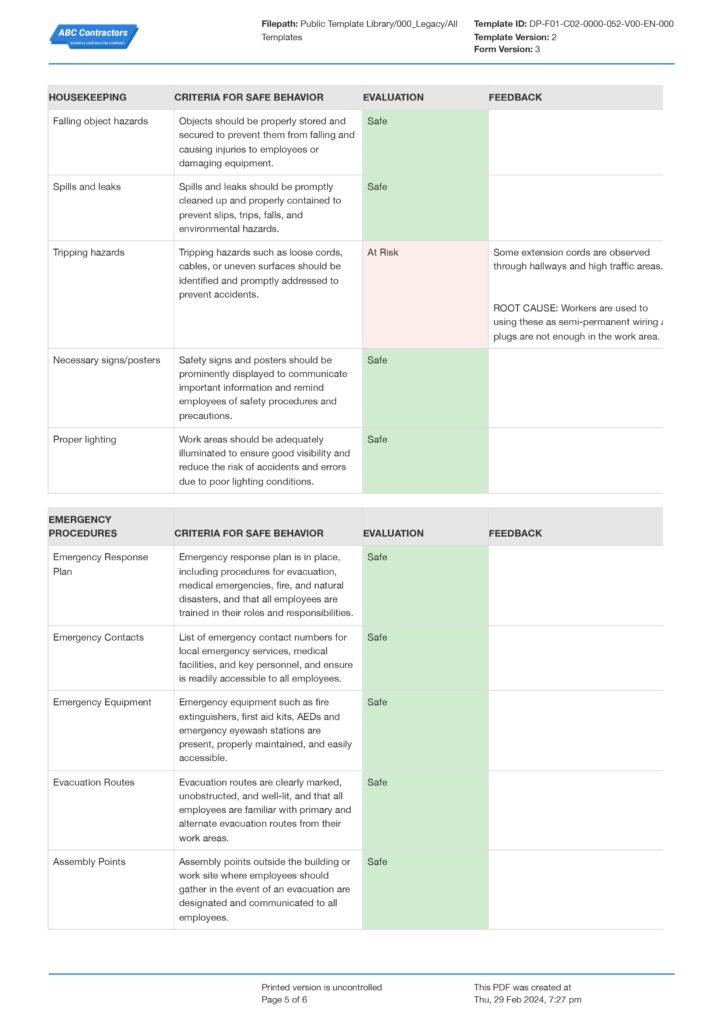Dashpivot Article – Examples of Behavior Based Safety Observations
Examples of Behavior Based Safety Observations
In this article, we will show you some proven examples of behaviour-based safety observations, and provide a number of resources you can use for your own safety observation processes.

What is behaviour-based safety observation?
Within the context of the workplace, a behavior-based safety observation, also known as a BBSO, is a method that is used to identify and rectify harmful behaviours. During this process, personnel are observed and analysed in order to find any behaviours that may result in accidents or injuries.
The objective is to detect any behaviours that may lead to accidents or injuries. A typical safety program, which focuses on finding and repairing dangers or flaws in the physical environment, takes a different approach than this sort of BBS observation, which is distinct from traditional safety programs.
The activities of the workers themselves are the primary focus of behavior-based safety observations, which are conducted instead.
How to Conduct Behavior-Based Safety Observations?
Based on the examples given above, the person who conducts the behaviour-based observation tries to inspect and check if the employees are adhering to proper workplace practices. Having known this, to conduct a behaviour-based safety observation, one must have a comprehensive checklist that contains all procedures, steps, and requirements when doing a certain activity.
In this part of the article, we will be discussing how to structure your behaviour-based safety observation to effectively conduct it and have a record that can be used as a resource in improving safety measures in the workplace.
Observation Details
Observation details contain information on what activity is being monitored for the behaviour-based safety observation. The information that must be found here is the following: Inspection Date, Activity, Name of Inspector, Location, and Inspection Sheet Number. Having this kind of information will make reviews easier since compiling them in this manner would make tracking these documents faster and easier.
Observation Criteria
Criteria on behaviour-based safety observation must be established to see if the practices, standards, and requirements are met by the workers. This will set the standards on how to evaluate behaviour based on the standards established in the workplace. The process will also help measure what is successfully implemented and what certain practices need further improvement.
Status
In addition to the existing observation criteria, this metric is also included. A straightforward indication of whether or not the condition has met the criteria is shown here. Including this field in your behavior-based safety observations may assist stakeholders in quickly determining what situations need change in a more efficient manner.
Feedback or Remarks
In this section of your behavior-based safety observation, inspectors have the opportunity to provide further feedback on the practice that is being evaluated. This subsection provides additional information on the factors that contributed to the scenario not meeting the standard. It is possible that including this extra information on your checklist can assist you in conducting a root cause investigation.
Root Cause Analysis
The process of determining the underlying causes of issues to find suitable remedies is known as root cause analysis, or RCA. Instead of offering temporary fixes, a root cause analysis seeks to identify the root cause of the issue and devise solutions that can effectively address the problem at hand. With that said, having this in your behaviour-based safety observation can help with providing accurate solutions to identified gaps in your inspection.
Action Items
After identifying the underlying problem, a solution is formulated to address the issue. To effectively implement the solution, action items are formulated. These are strategized procedures or steps that help the organisation successfully implement a certain solution. These are usually corrective actions, training suggestions, and changes to workplace procedures.
Scoring
A quantitative approach to the inspection requires the establishment of an efficient scoring system. The scoring system that is being set must be in line with the criterion established. Measurable information from scoring may be used to find gaps. These types of data can also be useful for presentation since they may be combined with graphs to provide a visual representation of what worked and what didn't.
Behavior-Based Safety Observation Example

Perform better behavior based safety observations with this free form
Examples of Behavior-Based Safety Observations
It's time to look at a number of examples of behavior-based safety observations. These categories are mostly targeted at particular fields in order to observe employee conduct in those disciplines more precisely. With this knowledge, the inspection will be more thorough and able to cover all possible hazards related to the field in question. Here are some examples of the kind of safety observations that may be made based on behaviour.
Examples of Behavior Based Safety Observations - Use of Protective Equipment
Personal protective equipment (PPE) is the primary defense of a worker to protect themselves from the hazards in their specific work environment. According to OSHA 1910.32 (a), protective equipment, including personal protective equipment for eyes, face, head, and extremities; protective clothing; respiratory devices; and protective shields and barriers, shall be provided, used, and maintained in a sanitary and reliable condition wherever it is necessary by reason of hazards of processes or environment, chemical hazards, radiological hazards, or mechanical irritants encountered in a manner capable of causing injury or impairment in the function of any part of the body through absorption, inhalation, or physical contact. Being a regulatory requirement, it would be helpful to observe how employees would adhere to wearing the right personal protective equipment in different circumstances in the workplace environment. To know which kind of PPE to wear on different kinds of hazards, read more at PPE Hazard Assessment.
Observation Examples:
- To check if workers are fully equipped with the OSHA-required PPE when doing welding work.
- To check if the workers are wearing hard hats in areas that require them to.
- To check if the workers followed the proper steps in wearing a harness to prevent malfunction and would cause them to fall.
Proper Ergonomics Safety
Ergonomic safety is the integration of practices in the workplace that considers the capabilities and limitations of the human body when doing specific activities. It is essential for preserving and preventing occupational injuries, particularly those that may endanger the human body's musculoskeletal system. The practices could be as simple as properly sitting down, lifting an object, or standing in the right place. Its focus is primarily targeted at minimizing muscle and bone strain when doing certain activities. It is important to gauge this area in your behaviour-based safety observation to help with risks that are associated with musculoskeletal disorders. With that, workplace fatigue would be minimised, ensuring the worker’s capability to execute jobs with efficiency.
Observation Examples:
- To check if employees are using their legs when lifting heavy objects.
- To check if workers know where to place themselves and avoid awkward positions when doing certain activities.
- To check if workers are using mechanical aids and tools to prevent overexertion of the body.
Adherence to Instructions Examples of Behavior Based Safety Observations
The purpose of giving workers instructions, such as manuals, operating instructions, and maintenance instructions, is to provide them with rules that will allow them to carry out a task or activity in a way that is safe, efficient, and secure. It is ensured that these instructions are recorded and standardised in order to guarantee that all individuals who carry out these particular actions will produce outstanding work and avoid the danger of accidents occurring in the workplace. It is essential to keep track of whether or not workers are complying with these guidelines to ensure that work practices are safe and that quality work is maintained.
Observation Examples:
- To check if workers are following the proper LOTO procedures.
- To check if truck operators are conducting an inspection before operating the heavy equipment.
- To check if welders are removing combustible materials in their area before starting their work.
Proper Tools and Equipment Usage
When it comes to doing our duties, we have devised creative tools and equipment that have made our work easier and more efficient, and we have made it a part of our routine to use these tools and equipment. However, in the workplace, it is very necessary to make certain that this equipment is used appropriately and that it is constantly in good condition. With that being stated, it is always the duty of the user to utilise these devices for the purpose for which they were designed and to ensure that they are functioning at their most effective level. It is possible to utilise the behavior-based safety observation to check this in order to determine whether or not the workers are engaging in this practice.
Examples of Observations:
- To check if workers are placing the power tools in proper storage areas after use.
- To check if workers are using the correct chain block based on the weight of the item to be lifted.
- To check if the workers are removing safety guards on power tools.
Following Emergency Procedures
It is the responsibility of every company to guarantee that employees get training on workplace emergency protocols. Identifying emergency escape sites, procedures to follow in the event of an emergency, and what to do in the event of a fire, earthquake, or other disaster are a few examples of this. All new staff should get training on these site-specific processes. Regular exercises or reviews of procedures are also necessary to make sure that everyone can respond appropriately and securely in the event of a genuine emergency. During these drills, one of the factors that could contribute to its success is employee behaviour. A worker’s engagement in such drills reflects his or her sense of urgency and mastery of the proper procedures if ever such emergencies occur. To better gauge this, a behavior-based safety observation could be incorporated into the drills to look at how workers react to such emergencies.
Observation Examples:
- To check if workers would contact the correct authorities whenever an emergency occurs.
- To check during earthquake drills if employees follow the duck, cover, and hold procedures.
- To check if workers know the fire-fighting team knows the correct fire extinguisher to use in certain situations.
examples of Behavior-Based Safety Observations Around the Practice of Housekeeping
Housekeeping in the workplace may be described as the actions that are carried out to establish or maintain an atmosphere that is safe, clean, and neat for employees to work in. Housekeeping that is done correctly may assist in reducing or eliminating dangers in the workplace. There is a high occurrence of incidents that are caused by poor housekeeping habits. OSHA 1915.81 (a)(1) states that the employer shall establish and maintain good housekeeping practices to eliminate hazards to employees to the extent practicable. Having said this, it must be observed that employees should adhere to proper housekeeping procedures to maintain a healthy and safe workplace. Observing the behaviour of employees if they are properly adhering to these procedures can help organisations gauge how much they need to reinforce to make sure that employees will retain the correct housekeeping procedures before, during, and after doing an activity.
Observation Examples:
- To check if employees are cleaning the tools they used after doing an activity and placing them in their respective storages.
- To check if employees are making sure that the area is free from any combustible materials before doing any hot work.
- To check if employees are properly segregating the generated solid waste in an activity.
Better manage all your behavior based safety processes
The need for thorough monitoring and documenting of both safe and dangerous behaviours in the workplace makes conducting behavior-based safety observations difficult and often results in laborious and prone-to-mistakes procedures.
Making your checklists by hand increases the likelihood of mistakes since manually assessing behavior-based safety observations during inspections may expose documents to dust and debris, rendering the text unreadable. Additionally, creating a report and manually entering data necessitate opening several applications and increase the likelihood of mistakes.
However, there is now a solution to these problems. The Dashpivot behavior-based safety checklist is a digital solution that helps you in your behavior-based safety inspection processes.
You can use the pre-built Behavior-Based Safety Checklist to ensure all of the information you need is captured every time. Having your checklist easily available on your device can remove the problems associated with the pen-and-paper method.
You can also conduct more efficient evaluations of all BBS observations with analytics tools, which are already built into the app, enabling you to make data-driven decisions and prioritize safety initiatives effectively. Your Behavior-Based Safety data is automatically loaded into the Analytics Dashboard to create detailed reports. This feature removes the hassle of manually inputting data into different apps just to generate reports and presentations. All these and more with the Behavior-Based Safety App.

WHS Workplace Inspection Checklist template
Keep all of your WHS workplace inspections and records streamlined and compliant.

Building Site Health and Safety Checklist template
Use this building site health and safety checklist to ensure all of the key aspects of health and safety are covered and compliant.

Safety Walk Checklist template
Streamline how you conduct, store and manage your safety walkthroughs using this smart template.





